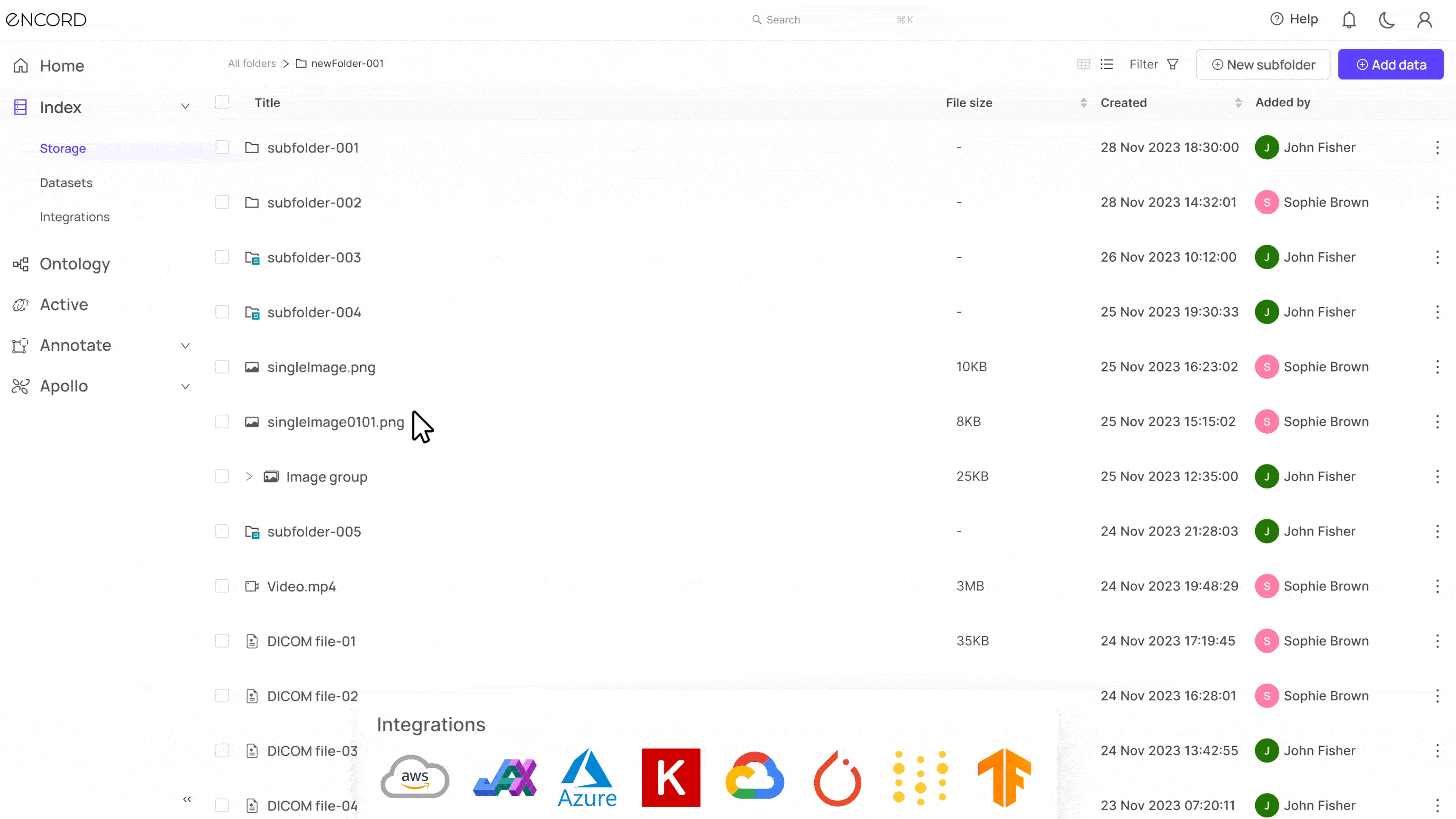Contents
What is Data Management?
Data Management Challenges
Factors for Selecting the Right Computer Vision Data Management Tool
Top 6 Data Visualization and Management Tools
Encord
Scenebox
Picsellia
DataLoop
Tenyks
Scale Nucleus
Data Visualization and Management: Key Takeaways
Encord Blog
Top 6 Computer Vision Data Management Tools

Google recently released its latest virtual try-on computer vision (CV) model that lets you see how a clothing item will look on a particular model in different poses.
While this is a single example of how CV is changing the retail industry, multiple applications exist where CV models are revolutionizing how humans interact with artificial intelligence (AI) systems.
However, creating advanced CV applications requires training CV models on high-quality data, and maintaining such quality is challenging due to the ever-increasing data volume and variety.
You need robust computer vision data management tools for scalable data management that let you quickly identify and fix issues before using the data for model development.
This article explores:
- The significance and challenges of data management.
- The factors to consider when choosing an ideal CV data management tool.
- Top CV data management tools.
What is Data Management?
Data management involves ingesting, storing, and curating data to ensure users can access high-quality datasets for model training and validation.
Data curation is a significant aspect of data management, which involves organizing and preprocessing raw data from different sources and maintaining transformed data to improve the quality of the data.
With the rise of big data, data curation has become a vital element for boosting data quality. Properly curated datasets increase shareability because different team members can readily use them to develop and test models. It also helps improve data annotation quality by letting you develop robust labeling workflows that involve automated data pipelines and stringent review processes to identify and fix labeling errors.
Data management ensures compliance with global data regulations such as the General Data Protection Regulation (GDPR) by implementing data security protocols and maintaining privacy guidelines to prevent users from exploiting Personally Identifiable Information (PII).
Data Management Challenges
While management is crucial for maintaining data integrity, it can be challenging to implement throughout the data lifecycle. Below are a few challenges you can face when dealing with large datasets.
Data Security
Maintaining data security is a significant challenge as data regulations increase and cyberattack risks become more prevalent. Implementing data room software can provide an additional layer of security and regulatory compliance, ensuring that sensitive data is managed and stored with the highest standards. The problem is more evident in CV models, which require training datasets containing images with sensitive information, such as facial features, vehicle registration numbers, personal video footage, etc. Even the slightest breach can cause a business to lose customers and pay hefty penalties.
Mitigation strategies can involve vigorous data encryption, regular security audits with effective access management procedures, and ethical data handling practices.
Data Annotation
Labeling images and ensuring accuracy is tedious, as it can involve several human annotators manually tagging samples for model development. The process gets more difficult if you have different data types requiring expert supervision.
A more cost-effective method for labeling images is to use novel learning algorithms, such as self-supervised learning frameworks, zero-shot models, and active learning techniques, with efficient review systems to automate and speed up the annotation workflow.
Managing complex data ecosystems
Most modern projects have data scattered across several platforms and have an on-premises, cloud-based, or hybrid infrastructure to collect, store, and manage information from multiple data sources. Ensuring integration between these platforms and compatibility with existing infrastructure is essential to minimizing disruptions to work routines and downtime.
However, managing multiple systems is challenging since you must consider several factors, such as establishing common data standards, maintaining metadata, creating shared access repositories, hiring skilled staff, etc.
Comprehensive data governance frameworks can be a significant help here. They involve data teams establishing automated data pipelines, access protocols, shared glossaries, guidelines for metadata management, and a collaborative culture to prevent data silos.
Large Data Volume and Variety
Data volume rapidly increases with new data types, such as point-cloud data from Light Detection and Ranging (LiDAR) and Digital Imaging and Communications in Medicine (DICOM) within computer vision. This raises management-related issues, as engineers require effective strategies to analyze these datasets for model optimization.
Efficient tools to handle various data types and storage platforms for real-time data collection can help deal with this issue.
Factors for Selecting the Right Computer Vision Data Management Tool
A recurring mitigation strategy highlighted above is using the right data management and visualization tools. Below are a few factors you should consider before choosing a suitable tool.
- User experience: Seek intuitive but also customizable tools, with collaborative features and comprehensive support services to ensure your team can use them effectively.
- Integration: Ensure the tool can integrate smoothly with your existing tech stack, supported by reliable data integration systems offering APIs and compatibility with various data formats to minimize disruptions and maintain workflow efficiency.
- Searchability: A tool with robust search capabilities, including AI-enhanced features, indexing, and diverse filter options, will significantly streamline selecting and using data.
- Metadata management: Metadata helps provide important information about the dataset such as the source, location, and timestamp. Choose a tool that provides robust metadata management, offering features like version control, data lineage tracking, and automated metadata generation.
- Security: Opt for tools with robust encryption protocols (e.g., AES, SSL/TLS) and compliance with industry standards like ISO 27001 or SOC2 to safeguard your data.
- Pricing: Evaluate the tool's cost against its features, scalability, and potential long-term expenses, ensuring it fits your budget and provides a high return on investment (ROI).
Top 6 Data Visualization and Management Tools
Below is a list of the six best data curation tools for efficient data management and visualization, selected based on functionality, versatility, scalability, and price.
Encord
Encord is a data development platform for managing, curating and annotating large-scale multimodal AI data such as image, video, audio, document, text and DICOM files. Transform petabytes of unstructured data into high quality data for training, fine-tuning, and aligning AI models, fast.
- Encord Index: Unify petabytes of unstructured data from all local and cloud data sources to one platform for in-depth data management, visualization, search and granular curation. Leverage granular metadata filtering, sort and search using quality metrics, and natural language queries to explore all your data in one place.
- Encord Annotate: Leverage SOTA AI-assisted labeling workflows and flexibly setup complex ontologies to efficiently and accurately label computer vision/multimodal data for training, fine-tuning and aligning AI models at scale.
- Encord Active: Evaluate and validate Al models to surface, curate, and prioritize the most valuable data for training and fine-tuning to supercharge Al model performance. Leverage automatic reporting on metrics like mAP, mAR, and F1 Score. Combine model predictions, vector embeddings, visual quality metrics and more to automatically reveal errors in labels and data.

Key Features
- User experience: Encord offers an easy-to-use user interface with self-explanatory menu options and powerful search functionality for quick data discovery. Users can query large scale datasets in everyday language to search for images and use relevant filters for efficient data retrieval.
- Support for petabyte-scale datasets: Encord enables teams to manage and curate millions of data files across any data modality including image, video, audio, text, document and DICOM with ease in seconds.
- Integration: Features an SDK, API, and pre-built integrations that let you customize data pipelines.
- Multimodal Search: Encord supports natural language search, external image, and similarity search to find desired visual assets quickly.
- Metadata management: Manage all your metadata in one place with simple metadata import and schemas.
- Custom & Pre-computed Embeddings: Explorer your data with Encords or your own embeddings using various embeddings-based features.
- Security: The platform is compliant with major regulatory frameworks, such as the General Data Protection Regulation (GDPR), System and Organization Controls 2 (SOC 2 Type 1), AICPA SOC, and Health Insurance Portability and Accountability Act (HIPAA) standards. It also uses advanced encryption protocols to ensure adherence to data privacy standards.
Additional Features
- Data Management and Curation: Encord Index offers tools for compiling raw data into curated datasets, organizing datasets into folders, and sending datasets for labeling. It includes capabilities to visualize, search, sort, and control data efficiently.
- Annotation types: Encord Annotate supports label editors and multiple data labeling methods for CV, such as polygons, keypoint selection, frame classifications, polylines, and hanging protocols.
- Active learning workflows: Encord provides features to create active learning workflows with Encord Active and Annotate.
- Model evaluation: It provides data-driven insights for model performance and label quality.
- Automated labeling: Encord gives you multiple distinct automated labeling techniques to help you create labels quickly and with little effort.
Best For
- Teams that wish for a scalable solution with features to streamline computer vision data management through automated labeling and easy-to-use UI.
Price
- Simple volume-based pricing for teams and enterprises.
Scenebox
Scenebox is a platform that provides data management features to discover, curate, debug, visualize, secure, and synchronize multimodal data for CV models.

Key Features
- User experience: Scenebox has an easy-to-use UI for managing datasets.
- Integration: It integrates easily with open-source labeling tools for streamlining data annotation.
- Searchability: It lets you search data with any format and metadata schema using the Python client and the web app.
- Metadata management: The tool allows you to add metadata to image annotations.
Additional Features
- Visualize embeddings: It lets you visualize image embeddings for data exploration.
- Model failure modes: The platform lets you identify labeling gaps by comparing predictions from other models.
Best For
- Teams that deal with massive unstructured data in different formats.
Pricing
- Pricing is not publicly available.
Picsellia
Picsellia is an AI-powered data management and data visualization platform with automated labeling functionality.

Key Features
- User interface: Picsellia has a user-friendly UI to upload, create, and visualize data.
- Searchability: It has an easy-to-use query-based search bar.
- Integration: Picsellia integrates with Azure, AWS, and Google Cloud.
- Metadata management: The tool offers pre-defined tags for creating metadata.
Additional Features
- Custom query language: The platform has a visual search feature to find similar images.
- Versioning system: Its built-in versioning system keeps track of all historical datasets.
Best For
- Teams that want a lightweight labeling and management tool for small-scale CV projects.
Pricing
- Picsellia offers standard, business, and enterprise plans.
DataLoop
DataLoop is a data management tool with cloud storage integrations and a Python SDK for building end-to-end custom data preparation pipelines for data labeling and model training.

Key Features
- Data security: DataLoop is GDPR, SOC, and ISO 27001 certified.
- User interface: The tool has an intuitive user interface.
- Searchability: The UI features a data browser for searching datasets.
- Integration: It integrates with cloud platforms like AWS and Azure.
- Metadata management: DataLoop lets you add metadata using the DataLoop Query Language.
Additional Features
- Support for multiple data formats: DataLoop supports several data types, including point-cloud data from LiDAR, audio, video, and text.
- Analytics dashboard: Features an analytics dashboard that shows real-time progress on annotation processes.
Best For
- Teams that are looking for a high-speed and data-type-agnostic platform.
Pricing
- Pricing is not publicly available.
Tenyks
Tenyks is an MLOps platform that helps you identify, visualize, and fix data quality issues by highlighting data gaps, such as outliers, noise, and class imbalances.

Key Features
- Data security: Tenyks is SOC 2-certified
- User interface: Tenyks has a user-friendly interface to set up your datasets.
- Searchability: The tool features a robust multi-modal search function.
Additional Features
- Mine edge cases: It offers engaging visualizations to identify data failures and mine edge cases.
- Model comparison: It lets you compare multiple models across different data slices.
Best For
- Teams that are looking for a quick solution to streamline data preprocessing.
Pricing
- Tenyks offers a Free, Starter, Pro, and Enterprise plan.
Scale Nucleus
Nucleus by Scale is a management tool that lets you curate and visualize data while allowing you to collaborate with different team members through an intuitive interface.
Key Features
- Data security: Nucleus is SOC 2 and ISO 27001 certified.
- User interface: Nucleus has an easy-to-use interface that lets you visualize, curate, and annotate datasets.
- Natural language search: It features natural language search for easy image data discovery.
- Metadata management: It allows you to upload metadata as a dictionary for each dataset.
Unique Features
- Find edge cases: The platform has tools to help you find edge cases.
- Model debugging: Nucleus also consists of model debugging features to reduce false positives.
Best For
- Teams that want a solution for managing computer vision data for generative AI use cases.
Pricing
- Nucleus offers a self-serve and enterprise version.
Data Visualization and Management: Key Takeaways
Data management is a critical strategic component for your company’s success. The following are a few crucial points you should remember.
- Importance of data management: Streamlined data management is key to efficient annotation, avoiding data silos, ensuring compliance, and ultimately leading to faster and more reliable decisions.
- Data curation: A vital element of data management, data curation directly impacts the quality and accuracy of the insights drawn from it.
- Management challenges: Continuous monitoring and updating are required to ensure data security and integrity in an increasingly complex and evolving data ecosystem.
- Data curation tools: Choose robust, adaptable tools to meet these challenges, focusing on those that offer ongoing updates and support to keep pace with technological advancements and changing data needs.

Explore our products
- The data curation process organizes and maintains AI data for use by experts in AI models.
- Transforming raw data into a usable format by performing feature extraction is an example of data curation.
- Data visualization helps summarize critical information in complex datasets, which helps in decision-making and better model training.
- Data management ensures consistency, accuracy, and relevance across the data lifecycle. In contrast, data curation mainly deals with data pre-processing and maintenance.
- Maintaining security, ensuring data flows seamlessly between different platforms, managing access, and handling large data volumes are a few significant challenges in data management.




